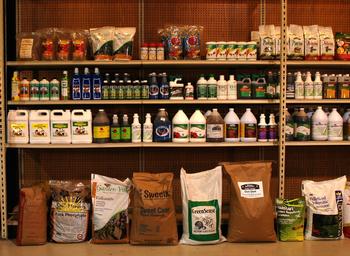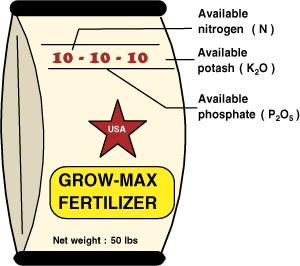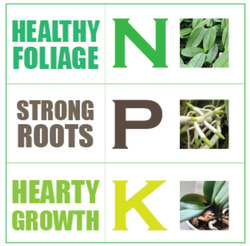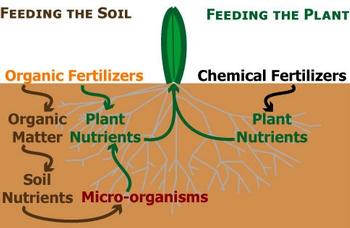Fertilizers: what does it all mean?
-
Perusing the shelves at your local nursery or home improvement store can be a perplexing experience. You will find a mind-boggling array of things to sprinkle, spread, spray, pour, mix, and pound. There's plant food, meal, pellets, all-in-one, time-release, and don't forget the conditioners, compost, mulches and more.
 Fertilizers: so many choices Photo courtesy of Wells Brothers Farm
Fertilizers: so many choices Photo courtesy of Wells Brothers Farm
Are they all fertilizers? Is a fertilizer the same thing as an amendment or mulch? If not, what’s the difference? And what do they do?First, let’s look at what plants need to grow and thrive. Plants require 17 chemical elements for healthy growth, categorized as follows:
1. Essential elements — carbon, hydrogen, and oxygen
2. Primary or macronutrients — nitrogen, phosphorus, and potassium
3. Secondary nutrients — calcium, magnesium, and sulfur
4. Micronutrients or trace elements — boron, chlorine, copper, iron, manganese, molybdenum, nickel, and zincMost of these elements already exist in the air or soil, and plants do not need replenishment. Some, like nitrogen, are rapidly used by growing plants and need replacement. Others may be present but are unavailable to the plant because of soil or environmental conditions.
Plants, like people, thrive on a well-balanced diet to keep them at their best. Sometimes the soil or environment may lack a key nutrient and a fertilizer fills in the nutritional gap, just as we might supplement our diet with a couple of vitamin C tablets if we are not getting enough from fresh fruits and vegetables.
Contrary to what product labels may claim, fertilizers are not plant food. Plants make their own food using water, carbon dioxide, and sunlight. The food they produce -- sugars and carbohydrates -- are combined with plant nutrients to create the proteins, enzymes, and vitamins that are vital to plant growth.
Next, let's clarify terminology for 3 key terms that are often misunderstood:
1 . Fertilizer: This is material added to the environment around a plant that provides specific nutrients. Fertilizers do not improve the condition of the soil. Generic fertilizer label. Photo courtesy of North Carolina Department of Agriculture
Generic fertilizer label. Photo courtesy of North Carolina Department of AgricultureFertilizers contain active ingredients, which are the materials responsible for the intended beneficial purpose of the product (for example, nitrogen or phosphorus). They can also include inert or filler ingredients without any nutritional value.
All fertilizer labels have three bold numbers representing the percent of primary nutrients by weight. The first number is the amount of nitrogen (N), the second number is the amount of phosphate (P), and the third number is the amount of potassium (K).
Nitrogen promotes healthy foliage, as it is critical for photosynthesis, plant metabolism, and many growth and development processes. Symptoms of a nitrogen deficiency may include slowed growth, pale, yellowing leaves (a condition called chlorosis), and the tips and margins of older leaves turning brown and dying. Because they tend to be heavy “feeders,” many vegetables other than legumes (beans and peas) are prone to this condition. Nitrogen deficiency can be addressed by amending the soil with manures, blood meal, or fish meal.
Phosphorus is also essential for photosynthesis and stimulates root and seed formation. Abnormally dark green, purple, or bronze foliage is a symptom of a phosphorus deficiency, as is browning along leaf margins. A phosphorus deficiency may also result in poor fruit or seed development. Phosphorus deficiency is relatively uncommon, but grasses, carrots, lettuce, spinach, and apples are more susceptible. Chicken manure is a good organic amendment, as it is high in phosphorus, while bone meal is the organic fertilizer containing the greatest amount of phosphorus.
Potassium improves the size and quality of fruits and increases disease resistance. A potassium deficiency causes leaf tips and margins to curl upward and eventually brown and die, starting with older leaves. Plants may have weak stems that fall over and may have poor fruit or seed development. Among vegetables and fruit crops, this deficiency is most common in potatoes, broccoli, tomatoes, apples, and raspberries. Steer manure has slightly more potassium than chicken manure. Other organic fertilizers containing potassium are blood meal and cocoa-shell meal. Note that cocoa-shell meal can be toxic to dogs and other animals and should be avoided by pet owners for this reason.Inorganic fertilizers are single or compounded chemical elements while organic fertilizers are derived from plant or animals. Complete fertilizers contain all three primary nutrients (nitrogen, phosphorus, and potassium), while incomplete fertilizers lack one or two of the primary nutrients.
2. Amendment: These are materials mixed into soil that indirectly aid plant growth by improving the condition of the soil like its texture or water retention. Examples include grass clippings, compost, and manure. When you buy a soil amendment, there are typically no legal claims about nutrient content or other helpful (or harmful) effects to expect on soil and plant growth. Amendments and mulches “feed the soil,” whereas fertilizers “feed the plant.”
3. Mulch: These are organic (compost, pine needles, wood chips, straw) or inorganic materials (landscape fabric, plastic, gravel) placed on the soil surface to help prevent weed growth and conserve moisture. Organic mulches also add organic matter to the soil as they break down.The law requires all manufacturers to guarantee the accuracy of the information on a product label -- if it is on the tag, it must be in the bag.
There are many forms and formulations of fertilizers available -- some of the more common include:
4. Liquid fertilizers deliver nutrients to roots immediately and are easy to use.
5. Solid fertilizers are sold as granules, powders, or pellets. They can be broadcast, scratched or dug into the soil, or used when planting.
6. Simple or single nutrient fertilizers like ammonium sulfate, urea or superphosphate are relatively inexpensive and generally very concentrated; use with care as they may burn tender growth due to high concentration.
7. Soluble complete fertilizers contain macro-, secondary, and micro-nutrients and get to the roots quickly. These chemically based products are very concentrated, so a little goes a long way. You need to dilute them according to the manufacturer's instructions.
8. Slow-release fertilizers are sold as spikes, tablets, or bead-like granules that release nutrients gradually over a fairly long period, three to nine months if the soil receives regular moisture. While convenient to use, as you only have to apply once in a season, they may not provide sufficient amounts of the macronutrients and require supplements; they also cost more than other alternatives.
9. Multipurpose products feature a fertilizer plus some other material with a different purpose; most often an insecticide or fungicide is added. This type of product is appropriate if you need the extra ingredient every time you fertilize. However, unless the extra ingredient is actually needed, it is more economical to use fertilizer alone (and it is much gentler on the environment).
10. Natural organic fertilizers such as chicken, duck or turkey manure, fish emulsion or blood meal -- add valuable organic matter to the soil, act slowly with less chance of burning, and are beneficial to microbes though results are less dramatic. Organic vs. Chemical Fertilizers. Photo courtesy of Matrixxco
Organic vs. Chemical Fertilizers. Photo courtesy of MatrixxcoDoes your garden need fertilization?
Deciding if organic or inorganic fertilizer is right for your garden depends on what you’re growing, the quality of your soil, and other environmental factors. Before you reach for an all-purpose tonic for your plants, learn what constitutes a balanced diet and good nutrition. For some specifics, refer to the links below.- Fertilize your lawn
- Fertilize your vegetable garden
- Fertilize your landscape
- Fertilize your fruit trees
Original article by Nanette Londeree for the Marin IJ and Brent McGhie for the Butte County Master Gardeners
Edited for the Leaflet by Lisa MacCubbin




